I. Introduction
“`html
Staying fit and healthy is essential for maintaining a high quality of life. However, many of us find it challenging to balance our busy schedules with regular gym sessions. The good news is that you can achieve your fitness goals without leaving your home. In this article, we will explore the best ways to stay fit at home, providing you with practical tips and techniques to keep you active and healthy.
Whether you’re looking to lose weight, build muscle, or simply improve your overall health, there are numerous exercises and activities you can do from the comfort of your own home. From bodyweight exercises to yoga routines, we’ll cover everything you need to know about home fitness.
One of the most effective ways to stay fit at home is through bodyweight exercises. These workouts require no equipment and can be done anywhere, making them perfect for those with limited space or no budget. Some popular bodyweight exercises include push-ups, squats, lunges, planks, and burpees.
Another great option for home fitness is yoga. Yoga not only helps improve flexibility but also enhances mental well-being. You can find numerous free yoga routines online that cater to different skill levels and goals. Whether you’re looking for beginner yoga poses or more advanced flows, there’s something for everyone.
For those who prefer more dynamic workouts, high-intensity interval training (HIIT) is an excellent choice. HIIT involves short bursts of intense exercise followed by brief periods of rest. This type of training can be done with minimal equipment and is highly effective for burning calories and improving cardiovascular health.
In addition to these physical activities, it’s also important to focus on nutrition. A balanced diet plays a crucial role in maintaining overall fitness. Here are some essential nutrients you should include in your diet:
- Protein: Essential for muscle growth and repair.
- Complex Carbohydrates: Provide energy for workouts.
- Fat: Important for hormone production and brain function.
- Fiber: Helps with digestion and satiety.
Finally, incorporating mental health practices into your routine can significantly enhance your overall fitness journey. Activities like meditation, deep breathing exercises, or simply taking time out each day to relax can help reduce stress levels and improve focus.
In conclusion, staying fit at home is not only possible but also highly rewarding. With the right combination of physical activities like bodyweight exercises, yoga routines, and HIIT workouts along with a balanced diet rich in essential nutrients, you’ll be well on your way to achieving your fitness goals from the comfort of your own home.
Remember always consult with a healthcare professional before starting any new exercise program or making significant changes to your diet.
Happy exercising!
“`
This HTML content includes bolded keywords like “how to stay fit at home“, “bodyweight exercises“, “yoga routines“, “high-intensity interval training (HIIT)“, and “nutrition“. It also includes a list of essential nutrients and emphasizes the importance of mental health practices in achieving overall fitness. The content is designed to be engaging and attractive while providing valuable information on staying fit at home
II. Setting Up Your Home Gym
A. Essential Equipment
When it comes to setting up a home gym, having the right equipment is crucial for how to stay fit at home. Here are some essential pieces you should consider:
- Dumbbells: These are versatile and can be used for a variety of exercises, making them a must-have for any home gym.
- Resistance Bands: Lightweight and portable, resistance bands offer a great way to work out without taking up much space.
- Adjustable Bench: An adjustable bench allows you to perform different types of exercises like bench presses and incline presses.
- Exercise Ball: Also known as a stability ball or Swiss ball, this can be used for core exercises and stretching.
- Jump Rope: A simple yet effective tool for cardio workouts.
Remember, investing in quality equipment will help you achieve your fitness goals more efficiently. For example, using dumbbells can help you build muscle mass which is essential for overall health and well-being.
B. Space Optimization
Optimizing your space is key when setting up a home gym. Here are some tips to help you make the most out of your available space:
- Utilize Vertical Space: Use wall-mounted racks or hooks to hang your equipment, keeping floors clear and maximizing vertical space.
- Choose Compact Equipment: Opt for compact versions of larger pieces like folding benches or mini steppers.
- Consider Multi-Functional Tools: Tools like kettlebells that can be used for multiple exercises reduce clutter and save space.
For instance, using resistance bands allows you to perform various exercises without taking up much floor space. This makes them ideal for smaller homes or apartments where space is limited.
Here’s a table comparing different types of equipment based on their space requirements:
| Equipment | Space Requirement |
|---|---|
| Dumbbells | Medium (depending on weight) |
| Resistance Bands | Low (portable) |
| Adjustable Bench | Medium (compact versions available) |
| Exercise Ball | Low (inflatable) |
| Jump Rope | Very Low (portable) |
By optimizing your space effectively, you’ll be able to create an efficient home gym setup that allows you to stay fit without sacrificing comfort or functionality.
For more detailed information on how to optimize your home gym space, check out this article from Healthline which provides comprehensive tips on setting up a home gym.
Staying fit at home requires dedication but with the right equipment and space optimization techniques, it becomes much easier. Remember always to consult with a healthcare professional before starting any new exercise routine.
By following these guidelines, you’ll be well on your way towards achieving your fitness goals while enjoying the convenience of working out from the comfort of your own home.
Happy exercising!
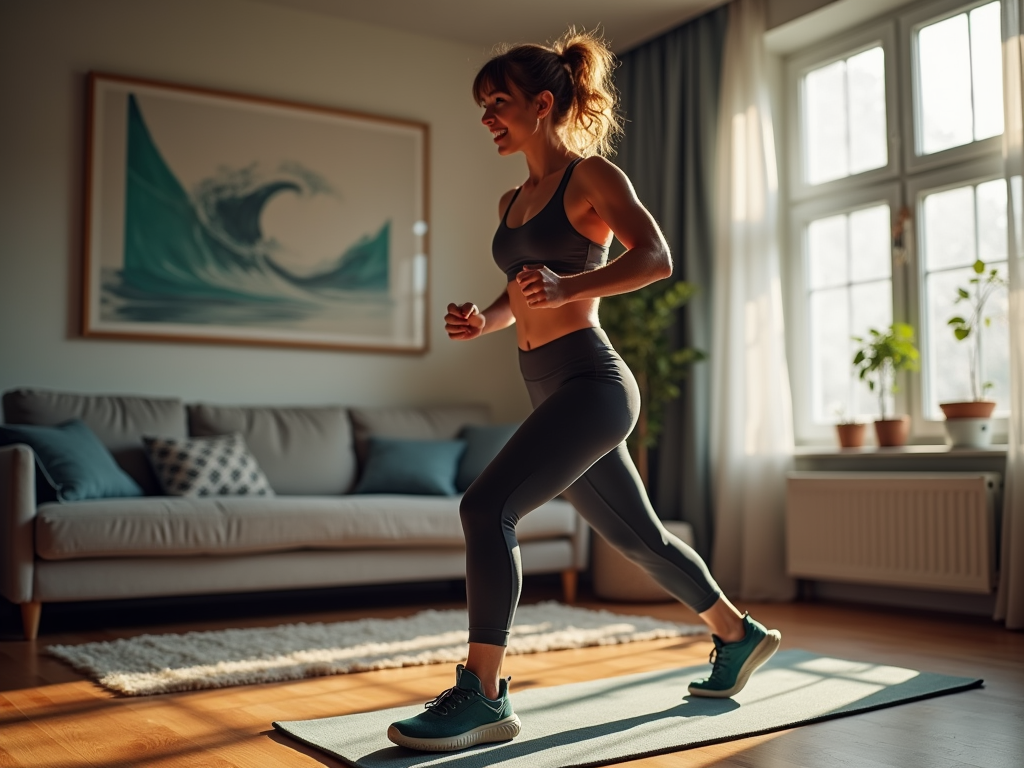
**”Exercise is not a chore; it’s a choice. Choose to move, choose to live.”** – **Ava Thompson, Personal Trainer**
III. Bodyweight Exercises
Staying fit at home is easier than you think, especially when you have the right bodyweight exercises in your arsenal. Whether you’re looking to improve cardiovascular health, build strength, or enhance flexibility, there are numerous exercises that can be done without any equipment. Here’s a detailed guide on how to incorporate these exercises into your daily routine.
A. PushUps and Variations
Push-ups are one of the most effective bodyweight exercises for building upper body strength. They target multiple muscle groups including the chest, shoulders, and triceps. Here are some variations you can try:
- Standard Push-Up: The classic version where you start in a plank position with your hands shoulder-width apart and lower your body until your chest almost touches the ground.
- Decline Push-Up: Place your hands on a surface lower than your feet to increase the difficulty level.
- Incline Push-Up: Place your hands on a surface higher than your feet to reduce the difficulty level.
- Diamond Push-Up: Place your hands closer together than shoulder-width apart for an added challenge.
Remember to start slow and gradually increase the number of repetitions as you build up your endurance.
B. Squats and Lunges
Squats and lunges are excellent for building lower body strength and improving balance. They target muscles in the legs, glutes, and core.
| Exercise | Description | Benefits |
|---|---|---|
| Squats | Stand with feet shoulder-width apart, then bend knees until thighs are parallel to ground. | Strengthens quadriceps, hamstrings, glutes, and core muscles. |
| Lunges | Step forward with one foot and lower body until back knee almost touches ground. | Improves balance and strengthens quadriceps, hamstrings, glutes, and core muscles. |
It’s important to maintain proper form when performing these exercises to avoid injury.
C. Planks and Core Workouts
Core workouts are essential for improving overall stability and reducing back pain. Planks are an excellent starting point for building core strength.
- Plank: Start in a push-up position but instead of lowering yourself down, hold steady for as long as possible.
- Side Plank: Lie on side with feet stacked and lift hips off ground; hold for 30 seconds on each side.
- Russian Twists: Sit on floor with knees bent and feet flat; twist torso from side to side touching hands behind back.
For added variety in your core workout routine, consider incorporating other exercises like bicycle crunches or leg raises.
Staying fit at home doesn’t have to be boring or monotonous. By incorporating these bodyweight exercises into your daily routine, you can achieve significant improvements in both physical health and mental well-being. Remember always to listen to your body and start slowly before increasing intensity or volume of workouts.
For more detailed information on how to incorporate these exercises into a comprehensive fitness plan, visit Healthline’s guide on bodyweight exercises.
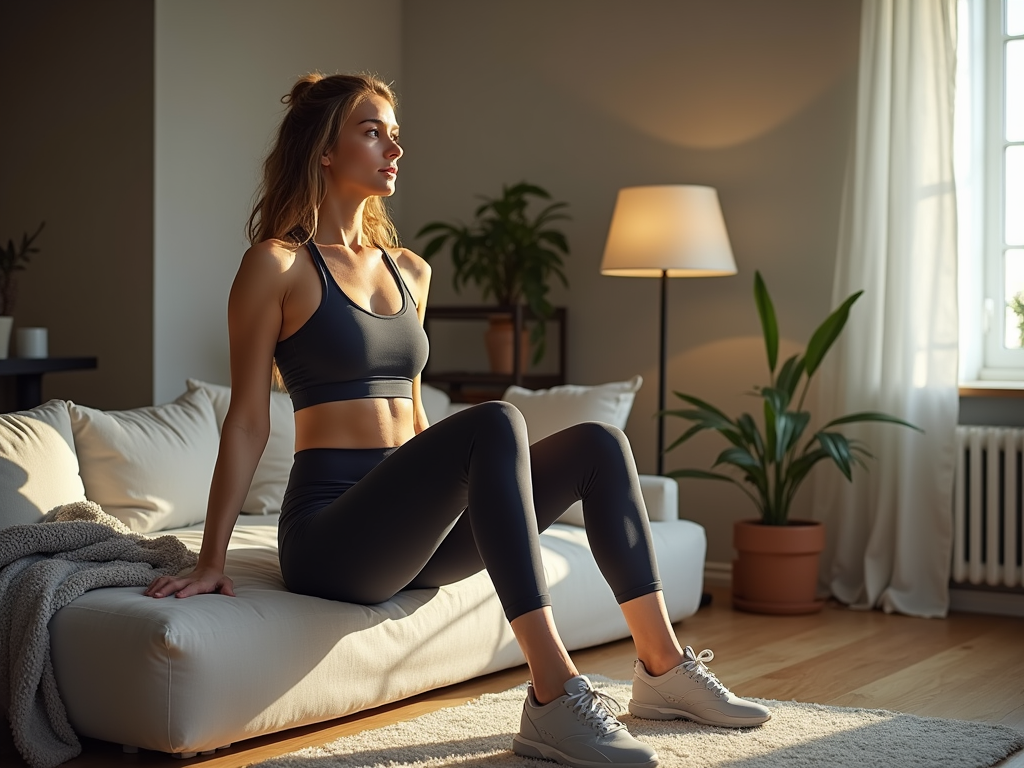
**”Home workouts are just as effective as gym sessions if you have the right mindset and a good routine.” – Emily Thompson, Personal Trainer**
IV. Cardio Workouts
Staying fit at home can be challenging, but with the right techniques and tools, you can achieve your fitness goals without stepping foot outside. Here are some effective cardio workouts you can do from the comfort of your own home:
A. Jumping Rope
Jumping rope is a classic cardio exercise that is easy to set up and requires minimal equipment. It’s an excellent way to improve your cardiovascular health and burn calories efficiently. Here are some tips for incorporating jumping rope into your routine:
- Warm-up: Start with a 5-minute warm-up session to get your heart rate up and prepare your muscles for the workout.
- Technique: Focus on proper technique to avoid injury and maximize the effectiveness of the exercise. Keep your knees slightly bent, swing the rope with both hands, and jump on both feet.
- Intensity: Increase the intensity by adding more jumps per minute or incorporating different types of jumps like double unders or side-to-side jumps.
B. High-Intensity Interval Training (HIIT)
HIIT involves short bursts of high-intensity exercise followed by brief periods of rest or low-intensity exercise. This type of training is highly effective for improving cardiovascular fitness and burning fat efficiently. Here’s how you can incorporate HIIT into your home workout routine:
- Sample Routine: Start with a 10-minute warm-up followed by 30 seconds of intense exercise (like burpees or mountain climbers), then rest for 30 seconds before repeating the cycle for 20-30 minutes.
- Variety: Mix up the exercises to avoid plateaus and keep things interesting. For example, you could alternate between sprints in place and jumping jacks.
- Progression: Gradually increase the duration and intensity of each interval as you get more comfortable with the routine.
C. Dance-Based Workouts
Dance-based workouts are fun and engaging ways to stay fit at home without feeling like you’re exercising. These workouts often combine elements of dance with aerobic exercise to create an enjoyable yet challenging routine. Here’s how you can incorporate dance-based workouts into your routine:
- Choose a Style: There are many styles to choose from, such as Zumba or Hip Hop Abs. Each style has its own unique moves and rhythms that can keep you engaged and motivated.
- Follow Along Videos: Use online resources like YouTube where you can find numerous dance-based workout videos tailored for different fitness levels.
- Make it Social: Invite friends over or join online communities where you can dance together virtually – this adds an element of fun and accountability to your routine.
Remember always to listen to your body and start slowly especially if you’re new to these types of exercises. It’s also important to consult with a healthcare professional before beginning any new exercise program.
For more detailed information on how to stay fit at home, including tips on nutrition and recovery, check out this article from Healthline.
| Exercise | Description | Benefits |
|---|---|---|
| Jumping Rope | A high-intensity cardio exercise that improves cardiovascular health and burns calories efficiently. | Improves cardiovascular health, burns calories efficiently, improves coordination. |
| HIIT | A high-intensity interval training that involves short bursts of intense exercise followed by brief periods of rest or low-intensity exercise. | Improves cardiovascular fitness, burns fat efficiently, increases metabolic rate. |
| Dance-Based Workouts | A fun and engaging way to stay fit at home combining elements of dance with aerobic exercise. | Improves coordination, boosts mood through music engagement, provides full-body workout. |
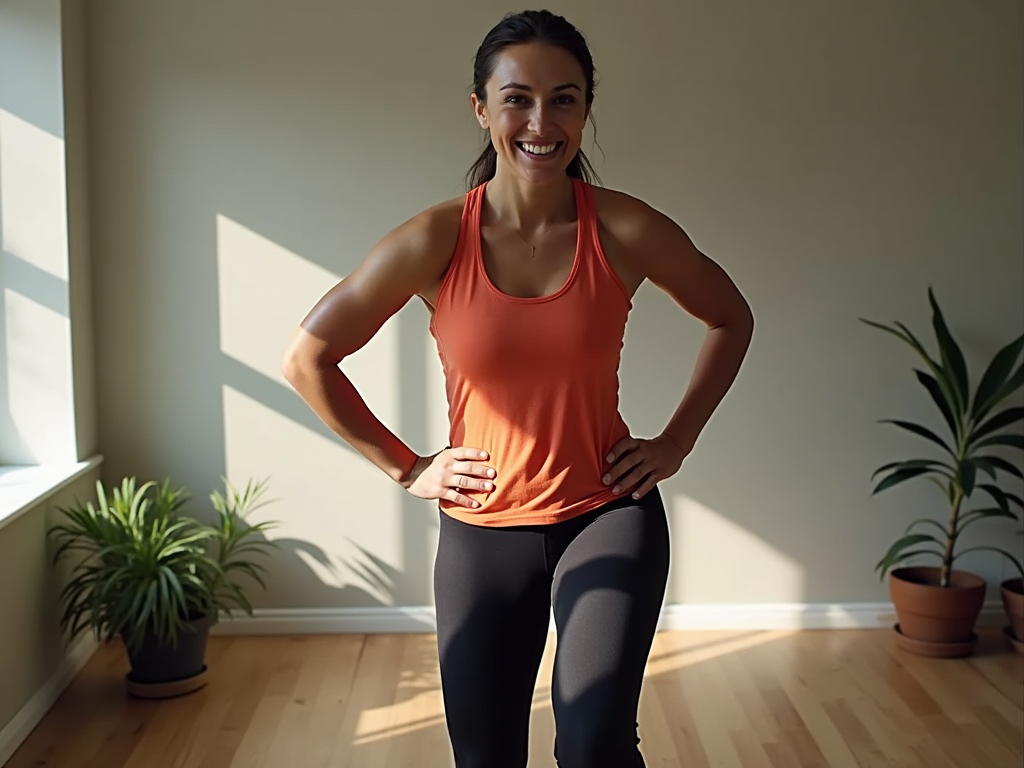
**Quote:** “Home workouts are not just for the body; they’re also a mental escape.”
V. Yoga and Stretching
A. Beginner-Friendly Poses
Staying fit at home can be as simple as incorporating beginner-friendly yoga poses into your daily routine. These poses are designed to be easy to learn and perform, making them perfect for those just starting out with yoga. Here are some essential beginner-friendly poses you can try:
- Mountain Pose (Tadasana): This foundational standing pose helps improve balance and posture.
- Downward-Facing Dog (Adho Mukha Svanasana): Stretches the entire back side of the body, from the shoulders to the heels.
- Cobra Pose (Bhujangasana): Strengthens the back muscles and opens up the chest.
- Child’s Pose (Balasana): A resting pose that stretches the back and hips.
B. Advanced Stretching Techniques
For those looking to take their fitness routine to the next level, advanced stretching techniques can be incredibly beneficial. These techniques not only improve flexibility but also enhance overall physical fitness. Here are some advanced stretching techniques you might find useful:
- Forward Fold (Uttanasana): Deeply stretches the hamstrings, calves, and spine.
- Seated Forward Fold (Paschimottanasana): Extends from the seated position, targeting the hamstrings and calves.
- Headstand (Sirsasana): Inverts the body, improving balance and strengthening the arms and shoulders.
C. Mindfulness in Yoga
Mindfulness is an integral part of yoga practice, helping you stay focused on your breath and movements. This mindfulness can significantly enhance your overall fitness journey by reducing stress levels and improving mental clarity. Here’s how you can incorporate mindfulness into your yoga routine:
- Focus on Breathwork: Pay attention to your breath as you move through each pose.
- Listen to Your Body: Be aware of any discomfort or pain; modify or rest when needed.
- Practice Meditation: Use meditation techniques before or after your practice for added relaxation benefits.
For more detailed information on how to stay fit at home using yoga and stretching techniques, consider visiting Yoga Journal, which offers comprehensive guides and tips for beginners and advanced practitioners alike.
| Pose | Description | Benefits |
|---|---|---|
| Warrior Pose (Virabhadrasana) | Stands with feet wide apart, one foot facing forward and the other backward. | Strengthens legs, hips, and core; improves balance. |
| Tree Pose (Vrksasana) | Stands on one leg while balancing on the other foot. | Improves balance, strengthens ankles, calves, and core. |
Remember that consistency is key when it comes to staying fit at home with yoga and stretching. Aim to practice at least three times a week, gradually increasing the duration as you become more comfortable with the poses.
By incorporating these beginner-friendly poses, advanced stretching techniques, and mindfulness practices into your daily routine, you’ll be well on your way to achieving optimal fitness from the comfort of your own home.
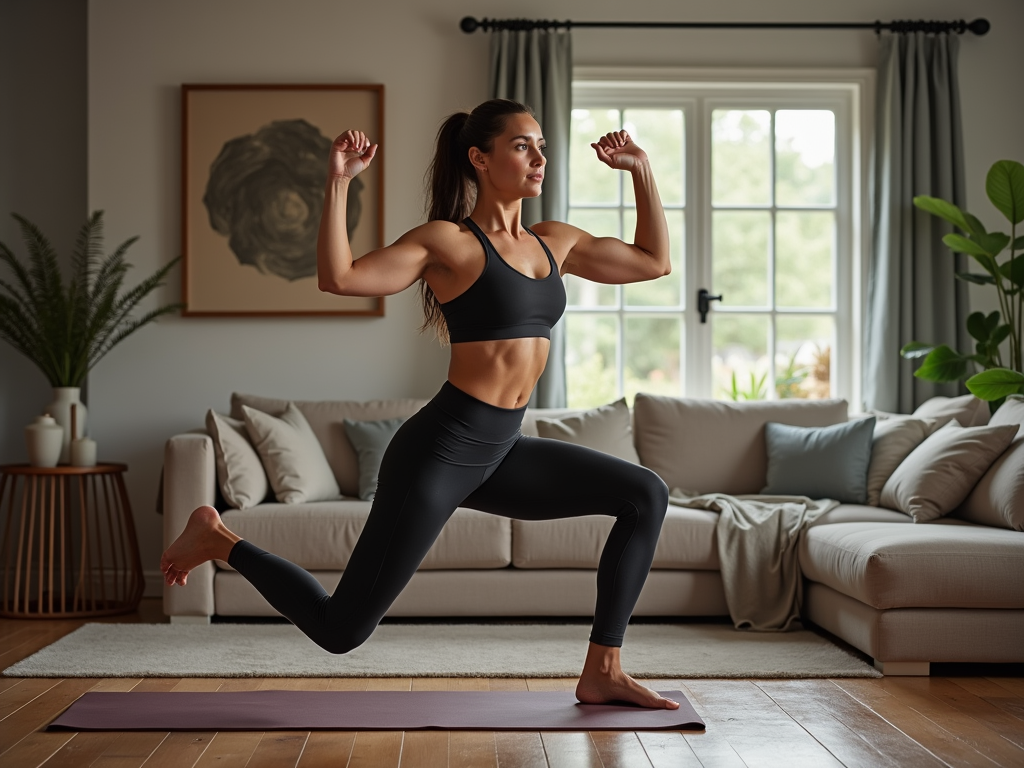
**”Home is where the heart is, and so is your fitness journey.”** – **Lena Thompson, Personal Trainer**
VI. Nutrition for Fitness
A. Balanced Diet Essentials
Staying fit at home requires a balanced diet that includes essential nutrients for energy and muscle recovery. A well-rounded diet should include a variety of foods from all food groups, such as protein, complex carbohydrates, and healthy fats. For example, lean proteins like chicken or fish, whole grains like brown rice or quinoa, and healthy fats like nuts or avocados are all crucial components of a balanced diet.
B. Meal Planning Tips
Meal planning is key to maintaining a healthy diet while staying fit at home. Here are some tips to help you plan your meals effectively:
- Set clear goals: Define what you want to achieve through your meal planning, whether it’s weight loss or muscle gain.
- Plan ahead: Create a weekly meal plan to ensure you have all the necessary ingredients.
- Include variety: Ensure your meals include a variety of foods to provide all essential nutrients.
- Keep it simple: Choose recipes that are easy to prepare and require minimal ingredients.
For instance, you can start your day with a balanced breakfast that includes oatmeal with fruits and nuts, followed by a mid-morning snack of carrot sticks with hummus. Lunch could be a lean protein like grilled chicken breast served with quinoa and steamed vegetables. Snacking on fruits or energy bars can help keep you fueled throughout the day.
C. Healthy Snacking Options
Healthy snacking is important for maintaining energy levels while staying fit at home. Here are some healthy snacking options:
- Fruits: Apples, bananas, berries
- Nuts: Almonds, walnuts, cashews
- Energy bars: Look for bars made from wholesome ingredients like nuts and dried fruits
- Yogurt: Greek yogurt with honey or berries
It’s also important to avoid unhealthy snacks like chips or candy. Instead, opt for healthier alternatives like trail mix made from nuts and dried fruits or homemade energy balls made from oats and honey.
For more detailed information on how to stay fit at home through nutrition, visit Healthline’s guide on staying fit at home.
| Meal | Example Ingredients | Why It’s Important |
|---|---|---|
| Breakfast | Oatmeal, fruits, nuts | Provides sustained energy throughout the morning. |
| Mid-Morning Snack | Carrot sticks, hummus | Boosts energy levels and supports healthy digestion. |
| Lunch | Grilled chicken breast, quinoa, steamed vegetables | Supports muscle recovery and provides essential nutrients. |
| Evening Snack | Fruits or energy bars | Helps maintain energy levels before bed. |
By following these meal planning tips and incorporating healthy snacking options into your daily routine, you can effectively support your fitness goals while staying fit at home.
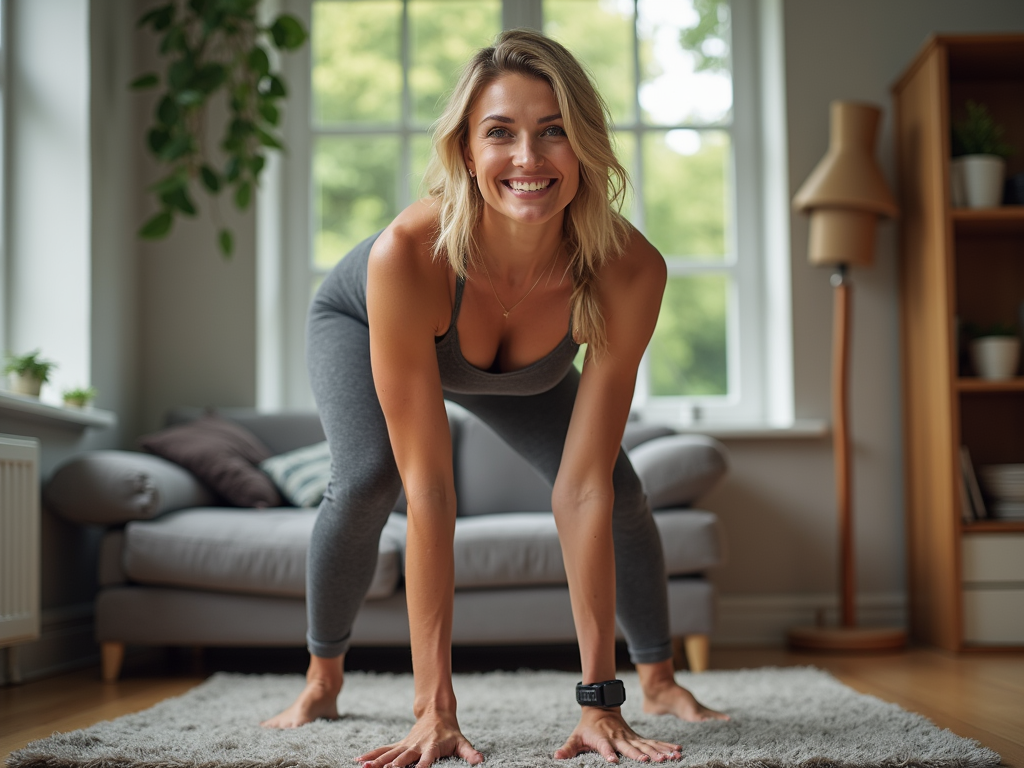
**Quote:** “Home workouts are the new gym sessions. Stay fit, stay happy!”
VII. Scheduling Your Workouts
A. Creating a Routine
Creating a routine is crucial when it comes to how to stay fit at home. A well-planned schedule helps you stay organized and ensures that you are consistently working out. Start by setting specific goals for your fitness journey, whether it’s to lose weight, build muscle, or improve overall health. Break down these goals into smaller, manageable tasks that can be incorporated into your daily routine.
For instance, if you want to stay fit at home, you might allocate specific times of the day for different activities such as cardio exercises, strength training, and flexibility exercises. You can use a planner or app to schedule these activities and set reminders to keep yourself on track.
B. Consistency is Key
Consistency is key when it comes to achieving and maintaining fitness. Aim to perform your workouts at the same time every day or week so that it becomes a habit. Consistency helps in building muscle and improving cardiovascular health over time.
Here are some tips for maintaining consistency:
- Set Realistic Goals: Ensure that your goals are realistic and achievable. Setting unrealistic goals can lead to frustration and burnout.
- Track Your Progress: Use a fitness tracker or log your workouts to monitor your progress. Seeing how far you’ve come can be a great motivator.
- Find an Exercise You Enjoy: Engage in activities that you enjoy, whether it’s running, yoga, or weightlifting. This will make sticking to your routine easier.
C. Avoiding Burnout
Avoiding burnout is essential when scheduling your workouts. Overexertion can lead to physical and mental exhaustion, causing you to give up on your fitness goals altogether. Here are some tips for avoiding burnout:
- Listen to Your Body: Rest when needed. If you’re feeling tired or experiencing muscle pain, take a day off or modify your workout routine.
- Vary Your Routine: Mix up your exercises regularly so that your body doesn’t get bored or accustomed to the same routine.
- Stay Hydrated: Proper hydration is crucial for maintaining energy levels during workouts. Drink plenty of water before, during, and after exercising.
Additionally, incorporating rest days into your schedule can help prevent overtraining. Aim for at least one or two rest days per week where you focus on recovery activities like stretching or light yoga.
D. Sample Workout Schedule
| Day | Activity | Duration |
|---|---|---|
| Monday | Cardio (Running or Cycling) | 30 minutes |
| Tuesday | Strength Training (Upper Body) | 45 minutes |
| Wednesday | Rest Day | – |
| Thursday | Flexibility Exercises (Yoga) | 30 minutes |
| Friday | Cardio (Swimming or Jumping Rope) | 30 minutes |
| Saturday | Strength Training (Lower Body) | 45 minutes |
| Sunday | Rest Day | – |
Remember, consistency and variety are key when it comes to how to stay fit at home. By creating a routine that includes a mix of cardio, strength training, and flexibility exercises, you’ll be well on your way to achieving your fitness goals.
For more detailed information on creating an effective workout routine at home, visit Healthline’s guide on creating a fitness routine.
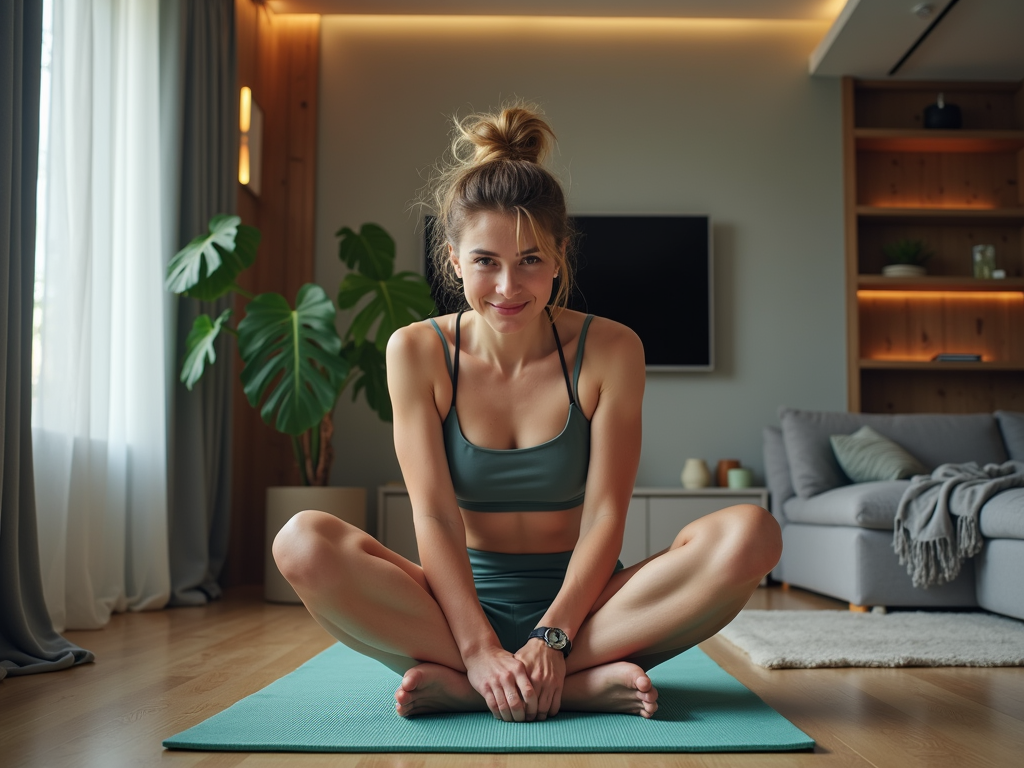
**Quote:** “Home workouts are the new gym sessions. Stay fit, stay happy!”
VIII. Incorporating Technology
Staying fit at home has never been easier with the advent of technology. Here are some innovative ways to incorporate tech into your fitness routine:
A. Fitness Apps
One of the most popular ways to stay fit at home is by using fitness apps. These apps offer a variety of workouts, from yoga and Pilates to strength training and cardio exercises. Some popular fitness apps include MyFitnessPal for tracking your diet and Nike Training Club for guided workouts.
Here are some key features you should look for in a fitness app:
- Customizable Workouts: Look for apps that allow you to create custom workout plans based on your goals and preferences.
- Progress Tracking: Features like step tracking, calorie burn, and progress charts help you monitor your progress over time.
- Community Support: Joining a community can provide motivation and accountability as you work towards your fitness goals.
- Video Instructions: Many apps offer video tutorials that demonstrate proper form and technique for various exercises.
B. Virtual Fitness Classes
Virtual fitness classes have become increasingly popular as they offer the convenience of working out from the comfort of your own home. These classes often include live sessions with certified trainers who guide you through various exercises.
Here are some benefits of virtual fitness classes:
- Convenience: You can attend classes at any time that suits you, whether it’s early morning or late evening.
- Variety: Virtual classes often offer a wide range of workouts including dance, strength training, and yoga.
- Personalization: Some platforms allow you to choose classes based on your fitness level and goals.
For example, Les Mills offers virtual classes that you can join from anywhere in the world.
C. Wearable Devices
Wearable devices like smartwatches and fitness trackers are another great way to stay fit at home. These devices track your activity levels, sleep patterns, and heart rate, providing valuable insights into your overall health.
Here’s how wearable devices can help:
- Step Tracking: Wearable devices accurately track your daily steps which is crucial for maintaining an active lifestyle.
- Heart Rate Monitoring: Continuous heart rate monitoring helps you understand how intense your workouts are and adjust accordingly.
- Sleep Analysis: Many wearables provide detailed sleep analysis which is essential for recovery and overall well-being.
For instance, Fitbit offers advanced features like guided breathing sessions and personalized recommendations based on your activity data.
Here’s a table summarizing some popular wearable devices:
| Device | Features |
|---|---|
| Fitbit | Step tracking, heart rate monitoring, sleep analysis |
| Apple Watch | GPS tracking, ECG monitoring, workout tracking |
| Garmin Vivosport | GPS tracking, heart rate monitoring, stress tracking |
By incorporating these technologies into your daily routine, you can achieve your fitness goals more effectively while enjoying the comfort of staying at home.
Remember to always consult with a healthcare professional before starting any new exercise program.
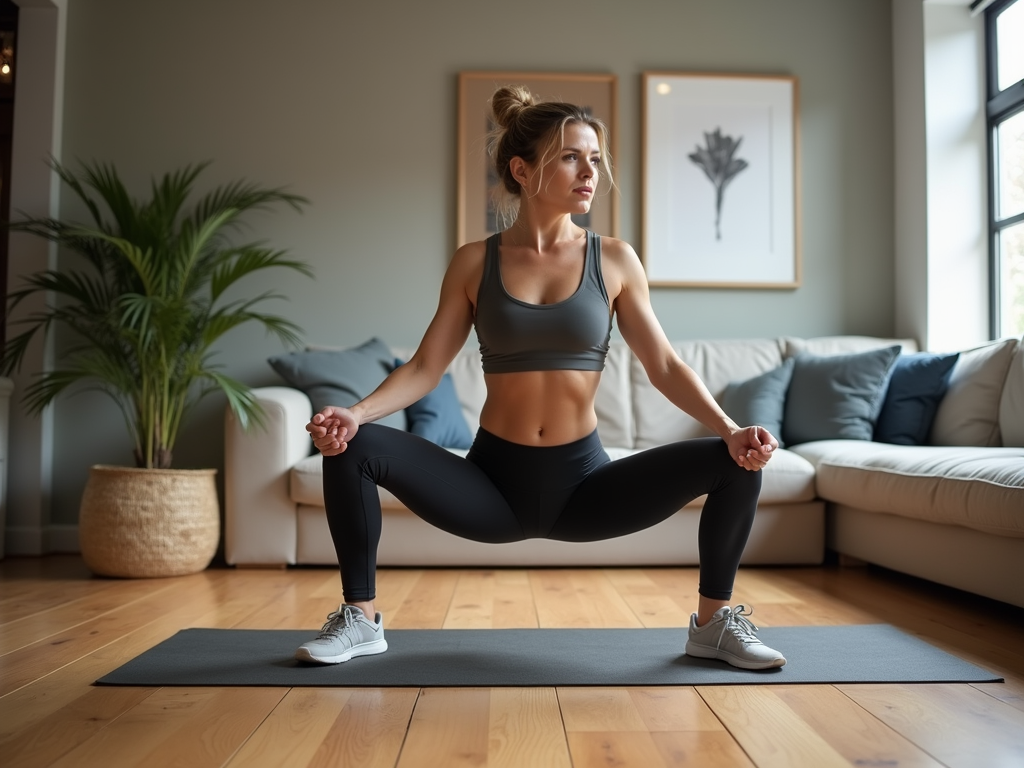
**Quote:** “Home workouts are not just about the body; they’re about the mind too. Stay focused, stay fit.”
IX. Involving Family Members in How to Stay Fit at Home
A. Partner Workouts
Staying fit at home can be a fun and engaging experience when you involve your family members. One of the best ways to do this is through partner workouts. These exercises not only help you stay active but also strengthen your bond with your loved ones. Here are some effective partner workout ideas:
- High-Intensity Interval Training (HIIT): This involves short bursts of intense exercise followed by brief periods of rest. You can do HIIT with your partner by alternating between exercises like burpees, jump squats, and mountain climbers.
- Resistance Band Exercises: Resistance bands are lightweight and portable, making them perfect for home workouts. You can use them for strength training exercises like bicep curls, tricep extensions, and chest presses.
- Yoga or Pilates: Partner yoga or Pilates sessions can be incredibly beneficial for both physical fitness and mental well-being. These low-impact exercises focus on flexibility, balance, and core strength.
B. Family Fitness Activities
Engaging in family fitness activities is another great way to stay active while spending quality time together. Here are some fun and engaging activities you can try:
- Household Chores as Exercise: Turn household chores into exercise by adding a bit of intensity. For example, vacuuming or mopping the floor can be done with more vigor to get your heart rate up.
- Family Dance Parties: Put on some upbeat music and have a dance party Dancing is a great way to get moving without feeling like you’re exercising.
- Outdoor Games: If the weather permits, play outdoor games like tag, hide-and-seek, or even set up a mini obstacle course in your backyard.
C. Encouraging Kids to Stay Active
Encouraging kids to stay active is crucial for their overall health and development. Here are some tips on how you can do this:
- Create a Fun Environment: Make exercise fun by turning it into games or challenges that kids enjoy.
- Lead by Example: Kids often mimic what they see their parents doing. Show them that staying fit is important by being active yourself.
- Involve Them in Planning: Let your kids help plan the family workout routine. This will give them a sense of ownership and make them more excited about participating.
For more detailed information on how to stay fit at home with your family, you might want to check out this article from Healthline.
| Exercise | Description | Benefits |
|---|---|---|
| Jumping Jacks | A classic cardio exercise that involves jumping up and spreading your legs apart while raising your arms above your head. | Improves cardiovascular health, burns calories, and increases muscle engagement. |
| Bodyweight Squats | A lower-body exercise where you stand with your feet shoulder-width apart and then lower your body down until your thighs are parallel to the ground. | Strengthens legs, glutes, and core muscles; improves balance and coordination. |
| Plank Hold | A core-strengthening exercise where you hold a position with your hands under your shoulders and toes on the ground. | Improves core strength, posture, and reduces back pain. |
Remember, staying fit at home with your family is all about finding activities that everyone enjoys and can stick to. By incorporating these tips into your daily routine, you’ll not only improve your physical health but also strengthen your family bonds.
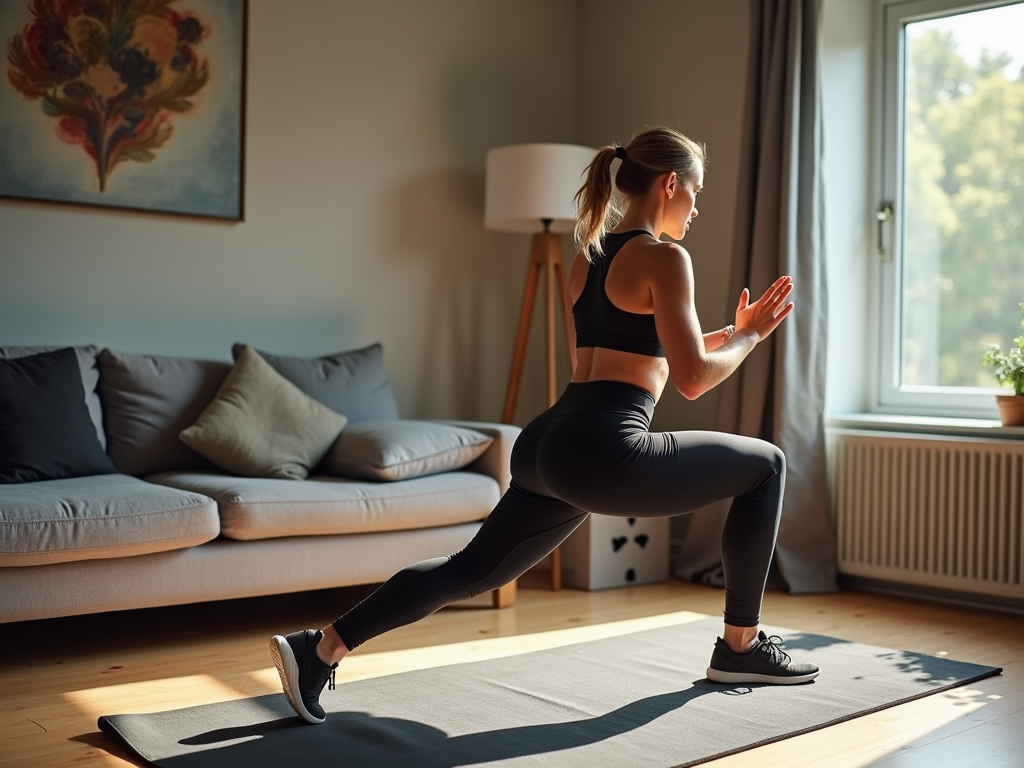
**Quote:** “Fitness is not a destination; it’s a journey. And you can start that journey right in your living room.”
X. Overcoming Obstacles
A. Motivation Techniques
Staying motivated is crucial when trying to stay fit at home. Here are some techniques that can help:
- Set Clear Goals: Define what you want to achieve and set specific, measurable, achievable, relevant, and time-bound (SMART) goals.
- Create a Routine: Establish a regular workout schedule to maintain consistency.
- Track Progress: Use a fitness tracker or log your workouts to monitor your progress.
- Find an Accountability Partner: Work out with a friend or family member for added motivation.
B. Overcoming Injuries
Injuries can be a significant obstacle in your fitness journey. Here’s how you can overcome them:
- Listen to Your Body: If you’re experiencing pain or discomfort, stop immediately and rest.
- Consult a Professional: Seek advice from a healthcare professional or a certified personal trainer if you’re unsure about the severity of the injury.
- Modify Your Routine: Adjust your workout routine to avoid exacerbating the injury while still maintaining some level of physical activity.
- Focus on Low-Impact Exercises: Engage in low-impact activities like yoga, swimming, or cycling that are easier on the joints.
C. Staying Committed
Staying committed is essential for achieving your fitness goals at home. Here are some strategies to help you stay on track:
- Make It Fun: Incorporate activities that bring joy and make exercise feel less like a chore.
- Find Variety: Mix up your routine with different types of exercises to avoid boredom.
- Use Technology: Utilize fitness apps and online resources for guided workouts and tracking tools.
- Reward Yourself: Celebrate small victories with non-food rewards like a relaxing bath or a new workout outfit.
Additionally, incorporating high-intensity interval training (HIIT) into your routine can be highly effective in keeping you engaged and seeing results quickly. HIIT involves short bursts of intense exercise followed by brief periods of rest, which can be adapted to various home workouts.
For more detailed information on how to incorporate HIIT into your home workout routine, you can refer to this article from Healthline.
| Exercise | Description | Duration |
|---|---|---|
| Bodyweight Squats | A classic lower body exercise that targets quadriceps, hamstrings, glutes, and core muscles. | 3 sets of 12 reps |
| Push-Ups | A full-body exercise that targets chest muscles, shoulders, triceps, and core muscles. | 3 sets of 12 reps |
| Plank | A core-strengthening exercise that targets abdominal muscles. | Hold for 30 seconds |
Remember that consistency is key when trying to stay fit at home. By incorporating these techniques into your daily routine and staying committed despite obstacles like injuries or lack of motivation, you’ll be well on your way to achieving your fitness goals.
Always prioritize proper form and safety during exercises to avoid injuries. If you’re new to working out at home or have specific health concerns, consider consulting with a healthcare professional or certified personal trainer for personalized advice.
With persistence and the right strategies in place, you can successfully overcome obstacles and maintain a healthy lifestyle even from the comfort of your own home.
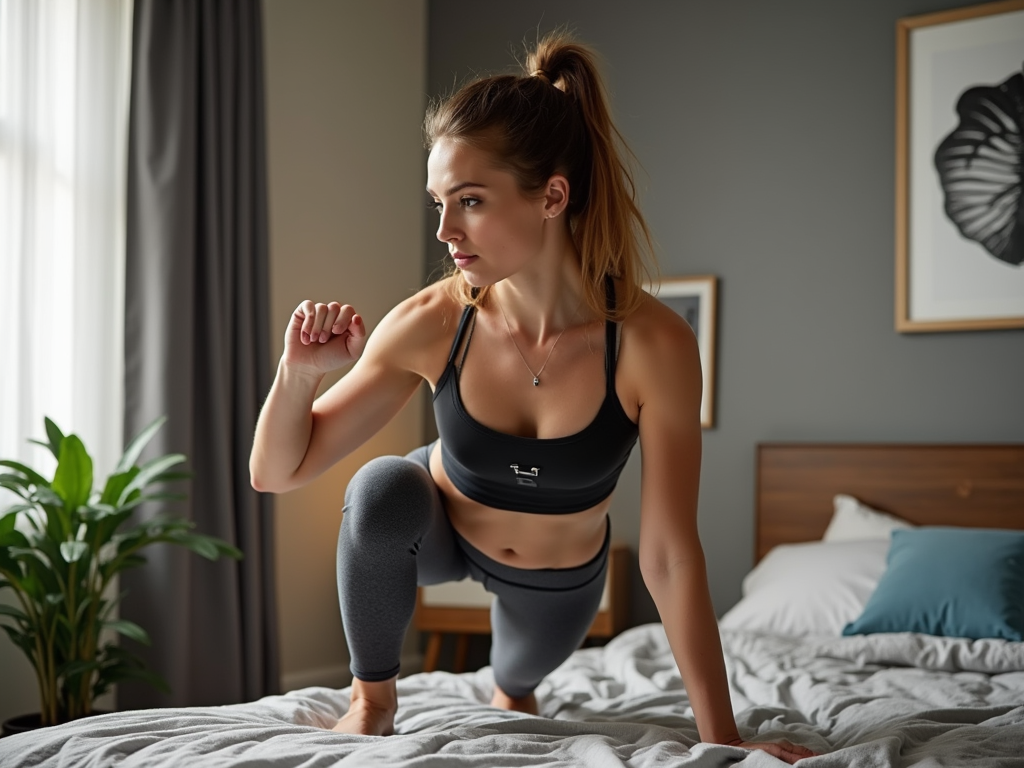
**Quote:** “Home workouts are not just about the body; they’re about the mind too.”
XI. Progress Tracking
A. Measuring Progress
Measuring progress is crucial when you’re working on how to stay fit at home. It helps you understand how far you’ve come and what areas need improvement. Here are some key metrics to track:
- Weight or Body Fat Percentage: Regularly measure your weight or body fat percentage using a scale or body fat caliper.
- Workout Performance: Track the number of repetitions, sets, and weight lifted during your workouts.
- Heart Rate: Monitor your heart rate during exercise to ensure you’re reaching the desired intensity.
- Progress Photos: Take regular photos to visually track changes in muscle mass and body composition.
For example, if you’re following a home workout routine, you might track the number of push-ups, squats, or lunges you complete each week. You can use apps like MyFitnessPal or Fitbit to log these metrics easily.
B. Setting Goals
Setting clear goals is essential for maintaining motivation and achieving success in your fitness journey. Here are some tips for setting effective goals:
- Specificity: Make sure your goals are specific and measurable. For instance, instead of saying “I want to get fit,” say “I will do 30 minutes of cardio exercise three times a week.”
- Realism: Ensure that your goals are realistic based on your current fitness level and schedule. Starting with small achievable milestones will help build confidence.
- Time-bound: Set deadlines for achieving each milestone. This could be weekly, monthly, or quarterly targets.
For example, if you’re new to working out at home, a realistic goal might be to complete one home workout session per day for the first week. As you progress, you can increase the frequency and intensity of your workouts.
C. Celebrating Milestones
Celebrating milestones is important for maintaining motivation and rewarding yourself for hard work. Here are some ways to celebrate your achievements:
- Treat Yourself: After reaching a milestone (e.g., completing 30 days of consistent workouts), treat yourself with something you enjoy but don’t regularly indulge in (like a favorite meal or dessert).
- Share with Friends/Family: Share your progress with friends and family; they can offer support and encouragement.
- Reflect on Progress: Take time to reflect on how far you’ve come since starting your journey. This helps solidify the sense of accomplishment.
For instance, if you’ve been following a home fitness program for three months and have noticed significant improvements in your overall health and fitness level, celebrate by taking a relaxing bath or enjoying a massage.
Remember that consistency is key when it comes to staying fit at home. Regularly tracking progress, setting achievable goals, and celebrating milestones will help keep you motivated throughout your journey.
For more detailed information on creating an effective home workout routine tailored specifically for beginners or advanced users alike, visit Healthline’s guide on fitness routines.
| Metrics | Description |
|---|---|
| Weight/Body Fat Percentage | Regularly measure weight or body fat percentage using a scale or body fat caliper. |
| Workout Performance | Track number of repetitions, sets, and weight lifted during workouts. |
| Heart Rate | Monitor heart rate during exercise to ensure reaching desired intensity. |
| Progress Photos | Take regular photos to visually track changes in muscle mass and body composition. |
By incorporating these strategies into your daily routine while focusing on how to stay fit at home, you’ll be well on your way towards achieving your fitness goals.

**Quote:** “Exercise is not a chore, it’s a choice. Choose to move every day.”
XII. Conclusion
As we conclude our comprehensive guide on how to stay fit at home, it’s clear that achieving a healthy lifestyle is within reach without the need for a gym membership. By incorporating the essential elements discussed in this post, you can transform your living space into a home gym that supports your fitness goals.
From bodyweight exercises like push-ups and squats to cardio workouts such as jumping rope and high-intensity interval training, we’ve covered a wide range of activities tailored for home use. Additionally, we’ve emphasized the importance of yoga and stretching for both physical flexibility and mental well-being.
Nutrition plays a crucial role in fitness, which is why we’ve provided tips on balanced diets and meal planning. Staying hydrated with healthy snacking options ensures you have the energy needed for your workouts.
Scheduling your workouts is key to consistency. By creating a routine that includes both cardio sessions and strength training, you’ll be well on your way to achieving your fitness goals. Don’t forget the importance of progress tracking – measuring progress helps set realistic goals and celebrate milestones along the way.
Technology can be your ally in fitness. Utilize fitness apps, join virtual classes, or wear wearable devices to monitor your progress. Involving family members in your routine can make it more enjoyable while also encouraging kids to stay active through partner workouts or family fitness activities.
Finally, overcoming obstacles is essential for long-term commitment. Use motivation techniques like setting small achievable goals or finding workout buddies who share similar fitness aspirations. Overcoming injuries requires patience but staying committed will help you bounce back stronger than ever.
- Key Takeaways:
- Transform Your Living Space: Convert any room into a functional home gym.
- Bodyweight Exercises: Push-ups, squats, planks are effective without equipment.
- Cardio Workouts: Jumping rope, HIIT sessions keep you active.
- Nutrition Tips: Balanced diets ensure energy for workouts.
- Technology Integration: Use apps, virtual classes, wearables for tracking progress.
- Family Involvement: Partner workouts encourage kids’ activity levels.
- Overcoming Obstacles: Stay motivated through small goals & injury recovery strategies.
By following these steps outlined in our comprehensive guide on how to stay fit at home, you’ll be well-equipped with practical tips tailored specifically for home-based fitness routines. Remember consistency is key – stay committed and celebrate each milestone achieved along this transformative journey towards better health!
Thank you for joining us on this journey towards understanding how easily one can stay fit at home
FAQ: how to stay fit at home
1. What are some basic exercises I can do at home?
You can start with push-ups, squats, lunges, planks, and bodyweight squats. These exercises work multiple muscle groups and require minimal equipment.
2. How often should I exercise at home?
Aim for at least 30 minutes of moderate-intensity exercise per session, ideally 3-4 times a week. Consistency is key when it comes to staying fit.
3. What are some effective home workout routines?
Consider HIIT (High-Intensity Interval Training) routines that involve short bursts of intense exercise followed by brief periods of rest. You can also follow along with online workout videos or apps like Nike Training Club or JEFIT.
4. How can I incorporate strength training into my routine?
Use household items like water bottles or cans as weights for strength training exercises like bicep curls and shoulder presses. You can also use resistance bands for added resistance.
5. Are there any yoga poses that can help me stay fit?
Yes Yoga poses like downward-facing dog, warrior II, tree pose, and plank pose can improve flexibility and balance while also engaging various muscle groups.
6. How important is nutrition when trying to stay fit at home?
Nutrition plays a crucial role in your fitness journey. Focus on consuming balanced meals rich in protein, healthy fats, and complex carbohydrates to support muscle growth and recovery.
7. Can I get enough cardio without going to the gym?
Absolutely You can do jumping jacks, running in place, burpees, or even dancing to get your heart rate up and burn calories effectively at home.
8. What are some tips for staying motivated while working out at home?
Set clear goals for yourself each week or month; track your progress through photos or measurements; find a workout buddy online; reward yourself after reaching milestones; mix up your routine regularly so it doesn’t become monotonous.
9. How do I avoid injury while exercising at home?
Warm up properly before starting any exercise session; listen to your body and rest when needed; use proper form when performing exercises; avoid overexertion by starting slowly and gradually increasing intensity.
10. Can I use household items as weights?
Yes Items like water bottles filled with sand or rice can serve as effective weights for strength training exercises like bicep curls and shoulder presses.
11. Are there any apps that can help guide me through home workouts?
Yes Apps like Nike Training Club, JEFIT, and Aaptiv offer guided workouts tailored specifically for home use with varying levels of intensity and duration.
12. How long does it take to see noticeable results from home workouts?
Noticeable results typically take around 4-6 weeks of consistent effort depending on individual factors such as starting fitness level and diet quality.

